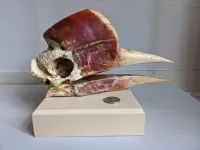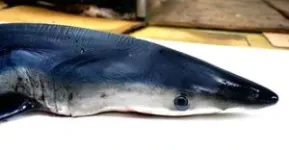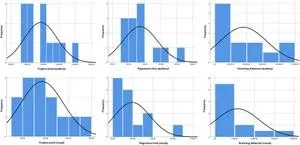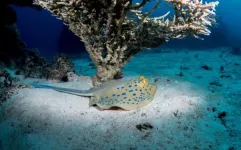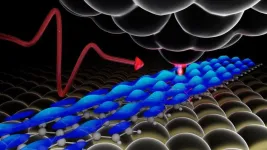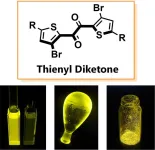(Press-News.org) New research reveals how the surprising internal anatomy of the helmeted hornbill’s casque allows it to withstand damage during aerial jousting battles with rivals. Researchers hope that this new understanding can help to conserve this critically endangered species, as well as provide new insights into developing impact-resistant bio-mimetic materials.
“When I started in Hong Kong, I visited City University of Hong Kong (HKU)’s conservation forensics group to chat about their research and they introduced me to this amazing bird, to its bizarre cranial anatomy, and to the threats posed to the species by the illegal wildlife trade,” says Dr Mason Dean, an Associate Professor of Comparative Anatomy at HKU.
The helmeted hornbill (Rhinoplax vigil) is prized in the illegal wildlife trade for its bulbous “casque”, a helmet-like protrusion on the front of its skull. While casques are a shared ornamentation amongst hornbills, they seem to play different roles for different species. In particular, whereas the casques of most species are hollow, that of the helmeted hornbill is fronted by a thick keratin layer (“hornbill ivory”) and packed with an exceptionally dense network of bone.
“As I learned more about this species, I discovered a cross-section of a dried skull in a museum, revealing a shocking trainwreck of trabeculae in the casque,” says Dr Dean. “When I heard that individuals are known to ram their casques together in mid-air displays, I just had to know more about the functional morphology.”
Trabeculae (inter-connected struts inside vertebrate bone) are one way that bones provide high strength and resistance to buckling, in the places where bones need it most. “Understanding hornbill anatomy and how it allows for this jousting behaviour can therefore give us clues about this elusive animal’s ecology and fundamental aspects of its life history and health,” says Dr Dean.
“Since hornbill functional anatomy is virtually unexplored, our findings will ideally also give new perspectives on the bio-inspired design of high-performing composites for tolerating damage from repeated collisions,” says Dr Dean. “We’re especially excited about the idea that helmeted hornbill could be a model for lightweight impact-resistant materials, as this could give solutions for where management of collision is vital, from helmets to vehicles and aerospace rover wheels.”
Dr Dean and his team used microCT to look inside of the casque’s different structures. “We have been focused on understanding the hierarchical architectures of the skull, uniting biology, materials science and engineering techniques,” he says. “We have enough samples that we can compare males and females, with some specimens that still have joint flexibility, and some where the rhamphotheca (the keratin sheath on the casque and mandible) can slide off.”
“Once we started the project a lot of really lovely hornbill enthusiasts came out of the woodwork to help,” says Dr Dean. “We’ve been able to get a detailed and quantitative picture of how the casque is constructed, how the bone interacts with the keratin, and the intricate latticework of bone trabeculae supporting the skull’s impact surface.”
Dr Dean and his team found that the hornbill’s trabeculae were on average as thick or thicker than those in an elephant’s femur, despite belonging to a much smaller animal – contrary to a common trend of trabeculae scaling with animal size. “I’ve used microCT to look at a big diversity of animal skeletons, but I have never seen bony trabeculae like the ones we’ve found in the hornbill,” says Dr Dean.
“That massive stand of trabeculae then channels back to the braincase, like a bundle of banyan tree prop roots, converging on a bony platform that’s far more reinforced than in other hornbills and relatives we’ve looked at,” says Dr Dean. “All of these anatomical features start to give a sense of how the skull of the helmeted hornbill is adapted to withstand one of the fastest known biological impacts, where males butt heads in ‘aerial jousting’ at the speed of automobile collisions.”
Due to the illegal wildlife trade, especially in Asia where Dr Dean and his team work, this species is now Critically Endangered on the IUCN Red List of Threatened Species, with much of its illegal trade through Hong Kong bound for Mainland China. “The helmeted hornbill is one of the largest hornbills species in Asia, with the keratin fronting its casque historically a target for the art and antique market for carving into ornamental wildlife products,” says Dr Dean. ““A large number of our skull specimens still contained the bullets that had likely killed the animal.”
“Since the species is elusive and hard to observe in the wild, there is a great need to improve knowledge of its biology, to preserve its habitat, protect dwindling wild populations, and to develop better tools to ID wildlife products,” says Dr Dean. “We hope projects like ours contribute to an understanding of species’ natural history and raise public awareness of the challenges facing biodiversity loss, while also ideally showing scientists that steps toward conservation need not solely come from conservation biologists!”
This research is being presented at the Society for Experimental Biology Annual Conference in Prague on the 2-5th July 2024.
END
Researchers have discovered the unique nanostructures responsible for the electric blue spots of the bluespotted ribbontail ray (Taeniura lymma), with possible applications for developing chemical-free colouration. The team are also conducting ongoing research into the equally enigmatic blue colouration of the blue shark (Prionace glauca).
Skin colouration plays a key role in organismal communication, providing life-critical visual clues that can warn, attract or camouflage. Bluespotted ribbontail ...
Painting roofs white or covering them with a reflective coating would be more effective at cooling cities like London than vegetation-covered “green roofs,” street-level vegetation or solar panels, finds a new study led by UCL researchers.
Conversely, extensive use of air conditioning would warm the outside environment by as much as 1 degree C in London’s dense city centre, the researchers found.
The research, published in Geophysical Research Letters, used a three-dimensional urban climate model of Greater London to test the thermal effects of different passive and active urban heat management systems, including painted “cool roofs,” rooftop solar panels, ...
One of the challenges of cramming smarter and more powerful electronics into ever-shrinking devices is developing the tools and techniques to analyze the materials that make them up with increasingly intimate precision.
Physicists at Michigan State University have taken a long-awaited step on that front with an approach that combines high-resolution microscopy with ultrafast lasers.
The technique, described in the journal Nature Photonics, enables researchers to spot misfit atoms in semiconductors with unparalleled precision. Semiconductor physics labels these atoms as “defects,” which sounds negative, but they’re ...
UNIVERSITY PARK, Pa. — Treating cancer can sometimes feel like a game of Whac-A-Mole. The disease can become resistant to treatment, and clinicians never know when, where and what resistance might emerge, leaving them one step behind. But a team led by Penn State researchers has found a way to reprogram disease evolution and design tumors that are easier to treat.
They created a modular genetic circuit that turns cancer cells into a “Trojan horse,” causing them to self-destruct and kill nearby drug-resistant ...
Pancreatic cancer is a particularly aggressive and difficult-to-treat cancer, in part because it is often resistant to chemotherapy. Now, researchers at Stanford have revealed that this resistance is related to both the physical stiffness of the tissue around the cancerous cells and the chemical makeup of that tissue. Their work, published on July 4 in Nature Materials, shows that this resistance can be reversed and reveals potential targets for new pancreatic cancer treatments.
“We found that stiffer tissue can cause pancreatic cancer cells to become resistant to chemotherapy, while softer tissue made ...
A research team led by Osaka University discovered that the new organic molecule thienyl diketone shows high-efficiency phosphorescence. It achieved phosphorescence that is more than ten times faster than traditional materials, allowing the team to elucidate this mechanism.
Osaka, Japan – Phosphorescence is a valuable optical function used in applications such as organic EL displays (OLEDs) and cancer diagnostics. Until now, achieving high-efficiency phosphorescence without using rare metals such as iridium and platinum has been a significant challenge. Phosphorescence, which occurs when a molecule transitions ...
More than two hundred international experts will take part in the 10th International Conference on Quarks and Nuclear Physics (QNP2024), a scientific summit organized by the UB Institute of Cosmos Sciences (ICCUB), which will be held in the Aula Magna of the Faculty of Biology at the University of Barcelona from 8 to 12 July. This meeting, hosted by the UB for the first time, will bring together world experts in the fields of nuclear physics and hadronic physics to discuss the latest advances in theory, experimentation and technology ...
Findings published in a new peer-reviewed paper in the British Journal of Educational Studies challenges the idea that academically selective schools are necessary for clever pupils to achieve good outcomes.
Selective schools are government-funded schools that enrol only the highest performing students. Pupils take a standardized entrance exam, from which the best-scoring are enrolled.
Some argue that selective schools are necessary for bright pupils to reach their full academic potential. Selective schools can ...
One of the greatest mysteries of science could be one step closer to being solved.
Approximately 80% of the matter in the universe is dark, meaning that it cannot be seen. In fact, dark matter is passing through us constantly – possibly at a rate of trillions of particles per second.
We know it exists because we can see the effects of its gravity, but experiments to date have so far failed to detect it.
Taking advantage of the most advanced quantum technologies, scientists from Lancaster University, the University of Oxford, and Royal Holloway, ...
This accolade highlights her pioneering research in the use of a diverse array of advanced microscopy techniques to uncover fundamental biophysical processes.
Currently holding a prestigious EMBL (European Molecular Biology Laboratory) Australia Group Leader fellowship, Dr Ananthanarayanan leads one of the largest and most dynamic research group in the EMBL Australia Node in Single Molecule Science, based in the Department of Molecular Medicine in the School of Biomedical Sciences.
Her research, which focuses on motor proteins and cytoskeleton dynamics, has set new standards ...
